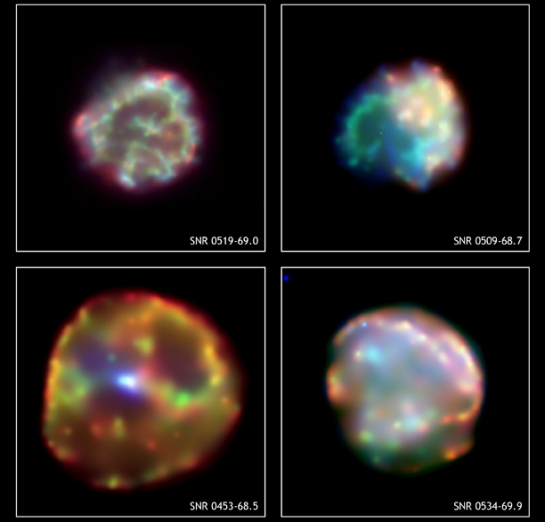Explanation: These four panels show x-ray images of expanding cosmic debris clouds, tens of light-years across, in nearby galaxy the Large Magellanic Cloud. The supernova remnants (SNRs) are the results of two types of stellar explosions and are arranged in order of apparent age or the time since light from the initial explosion first reached planet Earth. Clockwise starting at the upper left are remnants aged 600 years, 1,500 years, 10,000 years and 13,000 years. The first three result from a Type Ia explosion - the destruction of a white dwarf star by a thermonuclear blast triggered by mass accreted from a stellar companion. The fourth (lower left) is a Type II explosion - triggered by the final collapse of the core of a massive star. A neutron star, the remnant of the collapsed core, lies at its center.
1999 2000 2001 2002 2003 2004 2005 2006 2007 2008 2009 2010 2011 2012 2013 2014 2015 2016 2017 2018 2019 2020 2021 2022 2023 2024 2025 |
Yanvar' Fevral' Mart Aprel' Mai Iyun' Iyul' Avgust Sentyabr' Oktyabr' Noyabr' Dekabr' |
NASA Web Site Statements, Warnings, and Disclaimers
NASA Official: Jay Norris. Specific rights apply.
A service of: LHEA at NASA / GSFC
& Michigan Tech. U.
|
Publikacii s klyuchevymi slovami:
supernova - SN type Ia - type II - vzryvy sverhnovyh - Sverhnovye - ostatok Sverhnovoi
Publikacii so slovami: supernova - SN type Ia - type II - vzryvy sverhnovyh - Sverhnovye - ostatok Sverhnovoi | |
Sm. takzhe:
Vse publikacii na tu zhe temu >> | |
